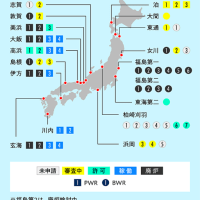05/16/2012 04:41 NHK news
Kyoto University -- a simulation -- "-- the Tokyo Bay cesium concentration -- March of the year after next -- the value of the sea near Fukushima -- almost -- the same -- "
Tokyo Bay To 4000 Bq of the year after next
The concentration of the radioactive cesium which flows into Tokyo Bay and with which the seabed is covered in the accident of the first nuclear power plant of Tokyo Electric Power Fukushima will become the highest in March of the year after next,
The research consortium of Kyoto University summarized the simulation result it is supposed that is locally amounted to 4000 Bq per kg of mud.
Survey data, such as a radioactive material which fell to Kanto in the accident of the first nuclear power plant of Fukushima, was used for the group of the Kyoto University disaster prevention research institute, and it performed the simulation which will predict the radioactive cesium which flows into Tokyo Bay, and with which the seabed is covered ten years after an accident.
I hear that as a result, the concentration of radioactive cesium will become the highest in March of the year after next, and it will be presumed near the mouth of a river in Arakawa that it amounts to 4000 Bq per kg of mud locally.
This is almost the same as the value south detected from the first nuclear power plant of Fukushima to the 16-km seabed in January this year.
I hear that it was calculated with about 500 Bq from 300 Bq per kg of submarine mud in the northern part of Tokyo Bay expected for concentration to become high comparatively when averaged.
While the radioactive materials which flow in from the surrounding river decrease in number in April of the year after next and afterwards, in order that diffusion may progress,
Concentration supposes that it will fall gradually.
Prof.Yamasaki Youryou who performed the simulation "the speed at which a radioactive material flows into Tokyo Bay with a rain quantity etc. may be rash.
While investigating the cumulative dosage to the seabed continuously, it is being said that whether fish and shellfishes are affected should supervise."
---
This
It is prediction of "quantity of the radioactive cesium which flows into Tokyo Bay from a river and with which the seabed is covered."
Governor Ishihara of Tokyo is reclaiming land also from the sludge of a sewer, and incineration ashes to Tokyo Bay.
I regard thinking that considering the thing it is not settled with such a figure as obvious .
It will continue more for a long period of time.
pathfinderk
05/16/2012 04:41 NHK news
京都大学がシュミレーション「東京湾セシウム濃度が再来年3月に福島近海の値とほぼ同じに」
東京湾 再来年4000ベクレルに
東京電力福島第一原子力発電所の事故で、
東京湾に流れ込んで海底にたまる放射性セシウムの濃度は
再来年の3月に最も高くなり、
局地的に泥1キログラム当たり4000ベクレルに達するとするシミュレーション結果を
京都大学の研究グループがまとめました。
京都大学防災研究所のグループは、福島第一原発の事故で関東に降った放射性物質などの調査データを使い、
東京湾に流れ込んで海底にたまる放射性セシウムを、事故の10年後まで予測するシミュレーションを行いました。
その結果、放射性セシウムの濃度は再来年の3月に最も高くなり、
荒川の河口付近では、局地的に泥1キログラム当たり4000ベクレルに達すると推定されるということです。
これは、ことし1月に福島第一原発から南に16キロの海底で検出された値とほぼ同じです。
比較的濃度が高くなるとみられる東京湾の北部では、
平均すると海底の泥1キログラム当たり300ベクレルから500ベクレル程度と計算されたということです。
再来年の4月以降は、周囲の河川から流れ込む放射性物質が減る一方で、拡散が進むため、
濃度は徐々に下がるとしています。
シミュレーションを行った山敷庸亮准教授は
「雨の量などによっては放射性物質が東京湾に流れ込む速度が早まる可能性がある。
海底への蓄積量を継続的に調べるとともに、魚介類に影響が出ないか監視すべきだ」と話しています。
ーーー
これは
「東京湾に河川から流れ込んで海底にたまる放射性セシウムの量」のみの予測ですね。
東京都の石原知事は、下水道の汚泥も、焼却灰も東京湾に埋め立てています。
その事を考えると、こんな数値では済まないと思うのは自明の理と思います。もっと長期間続くこととなります。pathfinderk




















※コメント投稿者のブログIDはブログ作成者のみに通知されます